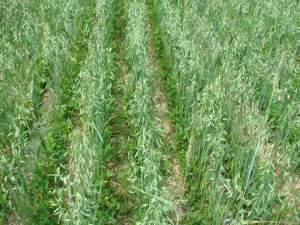Q: What should I plant this spring to reclaim goldenrod land, and what crop should I follow it with? The soil is acidic and low in nitrogen. I have also spread some wood ash. I hope to harvest the crop as haylage, and I am organic.
– Customer, Central VT
A: We recommend the Spring Champion Mix for a diverse spring mix (Hairy Vetch, Spring Peas, Spring Oats), seeding rate 125 lbs/A. This grows quickly in about 60 days, adds organic matter, and both the peas and vetch fix nitrogen. Following that, the ground can be prepared for a perennial grass or grass-legume mix to be seeded if a pasture or hay crop is desired.

Another possibility is to plant oats mixed with red clover this spring. The oats will go in the large seed box, and the clover in the small box. This is planted as a mix but also a relay crop scenario. After an early summer cutting of oatlage, the red clover will take off over the summer and can be cut for a clover hay. As it grows, it will also fix nitrogen and improve the fertility of the field. Weeds in the field will be weakened over time with repeated mowings.
The clover should be cut before bloom stage for best tillering, and cutting after September 1 will reduce winter survival. In Vermont, if you cut the oats for oatlage, you should get two cuttings of red clover before the fall. You can either take it out at that point for a fall seeding of a winter annual, or leave the clover in through the winter, cut it again the following spring (or turn it under as green manure), and then replant the field into the desired pasture crop or spring or summer annual. If weeds do not become a problem, the clover crop can also be left longer as a short-term perennial (2-3 years).
Green Spirit Italian Ryegrass blend can also be planted with the oats and red clover, or in place of the red clover. It will persist well through the following spring and can be managed in any of the above-mentioned scenarios. Green Spirit is not a good option for dry hay, however, and works best as haylage or baleage.
Alternatively, you can wait a little longer to plant and do a summer annual seeding such as millet or sudangrass in June, harvest or graze it in 35-40 days, and then again in August. Following this, plan a planting of triticale or Triticale Plus (triticale and annual ryegrass) in mid-September.
These spring and summer options are productive in a short growth period for flexibility in a time-limited rotation (like that found in Vermont’s growing season), produce high quality forage and a good amount of it, and improve and cover soil whether the crop is strictly a cover crop or intended as forage as well. You can improve a field and still benefit from the crop it produces in the meantime.
- Dave Wilson, Agronomist
Speak to an expert at King’s AgriSeeds now at 1-717-687-6224 or email us at [email protected].
